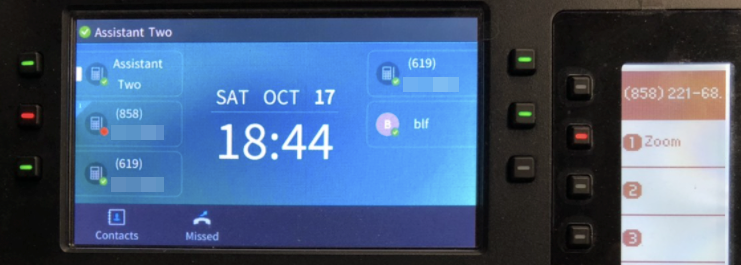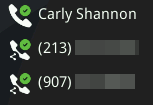Using call delegation (desk phones)
Call delegation (also known as shared line appearance) provides an easy way for phone users to assign others to handle calls on their behalf. For example, an executive can assign calling privileges to their assistant, allowing the assistant can make and receive calls on the executive’s behalf.
The following terms are used in this article:
- The delegator is the phone user who assigns phone privileges to another phone user or common area phone. Each delegator has up to 15 delegates.
- The delegate is the phone user or common area phone that makes and receives calls on the delegator's behalf. Each delegate can be assigned to a maximum of 15 delegators.
- Shared lines are direct phone numbers that belong to the delegator but can be used by their delegates.
Important:
- The screenshots in this article were taken from a Polycom VVX450, Yealink T56A, and AudioCodes 450HD/445HD. Your phone's interface may be different. The content in this article applies to most supported desk phones.
- This article contains instructions for delegators and delegates. See the appropriate sections for details relevant to your role.
Requirements for using call delegation (desk phones)
Shared line labels
After setting up call delegation, the lines on your phone will be labelled as follows:
Delegator
- If you only have one direct number, the line key will display your name.
- If you have more than one direct number, the line keys will display the number.
Delegate
- If you only have one direct number or don't have a direct number, the line key will display your name.
- If you have more than one direct number, the line keys will display the number.
- All shared lines (direct phone numbers that belong to the delegator) will display the number.
Note: You can customize the order and appearance of shared lines to help you identify them.
How to select a shared line
The delegator or delegate can select a shared line before making a call. Follow these quick start guides or instructions:
- Polycom VVX series
- Yealink T4 or T5 series
- AudioCodes
- 450HD: The 450HD has two sections to show line keys. Use the line keys to the right and left of the time to select a shared line. The top bar allows you to monitor call status and pick up a call held by the delegator. Tap a line. Alternatively, press up or down on the navigation control to select it, and then press the OK key.

- 445HD: The 445HD has two separate screens (main screen and sidecar). Use the main screen to select a line. Use the line keys to the right and left of the date/time to select a shared line. Use the sidecar to store your speed dials and answer held calls from the delegator. Press the line key adjacent to a line. Alternatively, press up or down on the navigation control to select it, and then press the OK key.

Delegator
Access the phone's home screen to see your own direct phone numbers which are shared lines. To identify who has access to these shared lines, see your call delegation settings.
Note: You can customize the order and appearance of shared lines to help you identify them.
Polycom

Yealink

AudioCodes

Delegate
You can see all shared lines on your phone's home screen. The line labeled with your name is only accessible by you.
Note: If you more than one direct phone number, your lines will not be labelled differently than the shared lines. You can customize the order and appearance of shared lines to help you identify them.
Polycom

Yealink

AudioCodes

How to make a call (delegator)
When the delegator makes a call after selecting a shared line, the shared line is marked as busy (usually indicated by a red icon or indicator light).
Delegator
Make a call after selecting a shared line.
Delegate
Go to the phone's home screen to see that the line is busy. This is usually indicated by a red icon. If your phone has physical line keys, the indicator light will turn solid red.
Polycom

Yealink

AudioCodes

How to make a call (delegate)
The delegate can make calls on the delegator's behalf by selecting a shared line. The shared line will be marked as busy.
Delegator
Go to the phone's home screen to see that the line is busy. This is usually indicated by a red icon. If your phone has line keys, the indicator light will turn red.
Polycom

Yealink

AudioCodes

Delegate
Make a call after selecting a shared line.
How to receive a call
The delegator and delegate will receive call notifications when someone calls a shared line. The call notification will indicate the shared line that is receiving the call.
If you have a phone with physical line keys, the indicator light will blink red.
How to transfer a call
The delegate can make or receive a call on a shared line then transfer it to the delegator:
Note: The screenshots below demonstrate a transfer from delegate to delegator. The same steps can be followed when transferring from delegator to delegate.
- Delegate: Make or receive a call then place it on hold using the call controls.
- Delegator: The line on hold will have one of these indications.
- Hold, Public Hold, or On Hold label
- red icon
- hold icon

- blinking red light if your phone has line keys
- Delegator: Answer the shared line that is on hold.
- Phone with line keys: Press the line key for the shared line that is on hold.
- Phone with touchscreen: Tap the shared line that is on hold.
- AudioCodes HD450: In the top bar, tap the line key with a 1 on the top-right corner, then tap the option with the hold icon.

- AudioCodes HD445: Press the line key on the sidecar.
- Yealink T5 series models: Press and hold the line key associated with the personal line. A menu will display showing the other call that was put on hold by the delegate. Use the arrow keys on the phone to select the other call, then press the OK button or Retrieve.
- Note: If the delegator is currently on a call, they should put in on hold using the in-call controls.
- When the call is finished, the delegator can end the call or transfer the call back to the delegate using the same process (place the call on hold then inform the delegate to answer the call).
How to transfer a call on a busy line
If another call comes in to a busy shared line, the delegator or delegate can answer the call and place it on hold.
Note: The screenshots below demonstrate a transfer from delegate to delegator. The same steps can be followed when transferring from delegator to delegate.
Delegate
Answer the call on a busy shared lined and place it on hold for the delegator.
Delegator (currently on a call)
Look for the line on hold that has one of these indications:
- Hold, Public Hold, or On Hold label
- red icon
- hold icon

- blinking red light if your phone has line keys
Tap the shared line or press the associated line key to answer the shared line that is on hold. The current call will be placed on hold. If you have one of these models, follow these steps:
- AudioCodes 450HD: In the top bar, tap the line key with a 1 on the top-right corner, then tap the option with the hold icon.

- AudioCodes HD445: Press the line key on the sidecar.
How to view call history
Delegates and delegators can view all call history for the shared lines. If a delegator or delegate deletes a call history entry related to a shared line, the entry will only be deleted for the person that made the deletion. You can view call history entry details to identify the shared line.
See these quick start guides for instructions:
How to view voicemail inbox
Delegates and delegators can play voicemail messages left for shared lines.
Note:
- Desk phones do not support downloading and deleting messages, and playing messages that the delegator or delegate has already listened to. Use the Zoom desktop client, web portal, or mobile app to manage your voicemail.
- We recommend using the Zoom desktop client to check voicemail for shared lines so you can easily identify messages. It can be difficult for delegates to identify who the voicemail was left for when using a desk phone to check voicemail for shared lines.








